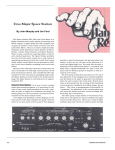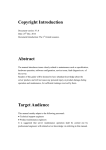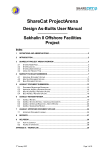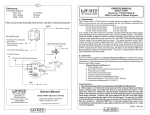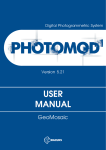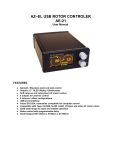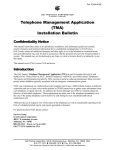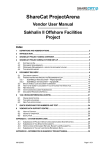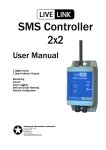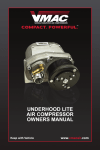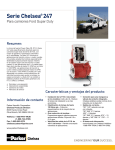Download In Vehicle Monitoring System Procedure
Transcript
IN VEHICLE MONITORING SYSTEM PROCEDURE Rev. 01 Contents: 1 INTRODUCTION ...................................................................................................................................... 4 1.1 PURPOSE ............................................................................................................................................ 4 1.2 SCOPE ................................................................................................................................................ 4 1.3 TERMINOLOGY .................................................................................................................................... 4 1.3.1 Definitions .................................................................................................................................. 5 1.4 USER NOTES ...................................................................................................................................... 5 1.4.1 Review and Improvement .......................................................................................................... 5 2 RISKS & CONTROLS.............................................................................................................................. 6 3 RESPONSIBILITIES ................................................................................................................................ 6 3.1 SPECIFIC RESPONSIBILITIES................................................................................................................. 6 3.1.1 Contract Holders ........................................................................................................................ 6 3.1.2 Managers ................................................................................................................................... 7 3.1.3 IVMS Team ................................................................................................................................ 7 3.1.4 Drivers ........................................................................................................................................ 8 3.1.5 Vehicle Maintenance Staff ......................................................................................................... 8 3.1.6 Authorised Installation Technicians ........................................................................................... 8 4 REFERENCES ......................................................................................................................................... 8 5 IVMS PROCEDURE................................................................................................................................. 8 5.1 BACKGROUND ..................................................................................................................................... 8 5.2 INSTALLATION, MAINTENANCE, REPAIR AND REMOVAL .......................................................................... 9 5.2.1. Installation, Maintenance and Repair ........................................................................................ 9 5.2.2. Removal of IVMS Unit ............................................................................................................... 9 5.3. PID MANAGEMENT .............................................................................................................................. 9 5.3.1. PID issuing for Staff and (Sub)contractor Drivers ...................................................................... 9 5.3.2. Spare PID Issuing .................................................................................................................... 10 5.3.3. Lost/Stolen PID ........................................................................................................................ 10 5.3.4. Return of PID ........................................................................................................................... 10 5.3.5. Unauthorized Use of PID ......................................................................................................... 10 5.4. MONITORING AND REPORTING ........................................................................................................... 10 5.4.1. MONITORING ................................................................................................................................. 11 5.4.2. REPORTING ................................................................................................................................... 11 5.5. FEEDBACK AND COACHING ................................................................................................................ 12 5.5.1. POSITIVE AND NEGATIVE CONSEQUENCE MANAGEMENT .................................................................. 12 5.5.2. POSITIVE CONSEQUENCE MANAGEMENT (REWARD AND RECOGNITION) ........................................... 12 5.5.3. DRIVER’S BEHAVIOUR MANAGEMENT ............................................................................................... 13 5.6. REVIEW ............................................................................................................................................ 14 5.7. INCIDENT INVESTIGATION ................................................................................................................... 14 5.8. TRAINING .......................................................................................................................................... 14 APPENDIX 1: USER FEEDBACK FORM .................................................................................................... 16 APPENDIX 2: IVMS SYSTEM CHECK ........................................................................................................ 17 APPENDIX 3: POST INSTALLATION CHECK LIST ................................................................................... 18 APPENDIX 4: IVMS INSTALLATION ACT .................................................................................................. 19 APPENDIX 5: IVMS BRIEFING FORM FOR SIEMENS VDO PID .............................................................. 20 APPENDIX 6. COMPANY’S IVMS FEEDBACK FORM ............................................................................... 22 APPENDIX 7: SEIC IVMS FEDBACK .......................................................................................................... 23 APPENDIX 8: SIEMENS VDO PID ISSUE FORM ....................................................................................... 24 APPENDIX 9: VEHICLE / DRIVER / TRIP INFORMATION REQUEST CHECKLIST................................. 25 Document No. 1000-S-90-04-P-0076-00-E Page 2 of 28 IN VEHICLE MONITORING SYSTEM PROCEDURE Rev. 01 APPENDIX 10: IVMS EQUIPMENT TRANSFER ACT ................................................................................ 26 APPENDIX 11: REVISION DETAILS ........................................................................................................... 28 Document No. 1000-S-90-04-P-0076-00-E Page 3 of 28 IN VEHICLE MONITORING SYSTEM PROCEDURE 1 Introduction 1.1 Purpose Sakhalin Energy operations rely heavily on road transport for the movement of personnel and equipment. It is recognized by the Company that inadequate management controls represent threats that are the root cause of a significant number of road traffic incidents. The Company acknowledges the necessity to install the IVMS to the vehicles operated by the Company in order to reduce the number of Road Traffic Incidents, increase the service life of the fleet and reduce unscheduled maintenance of vehicles and its associated costs, to monitor driving activities, and to prevent unauthorized use of vehicles involved in SEIC Company operations. The below procedure describes the controls to be executed and processes to be followed in implementation of In Vehicle Monitoring Systems. 1.2 Scope This Procedure applies to the road transport operations carried out by Sakhalin Energy and its Contractors and Subcontractors carrying out work for Sakhalin Energy as defined by the Contract Mode. This Procedure addresses the following issues: 1.3 Roles and Responsibilities Installation and Maintenance Driver Key (PID) Management Monitoring and Reporting Feedback and Coaching Driver Behaviour Management Incident Investigation Training Review Terminology TERM Shall Should May Document No. 1000-S-90-04-P-0076-00-E MEANING Indicates a mandatory course of action. Indicates a preferred course of action. Indicates a permitted course of action. Page 4 of 28 Rev. 01 IN VEHICLE MONITORING SYSTEM PROCEDURE 1.3.1 Definitions TERM IVMS In Vehicle Monitoring System RTI Road Traffic Incident Database Fleet Management software database RF Law Russian Federation Law OBC On Board Computer Driver Any person who drives a company owned, contracted or leased vehicle on Company business Responsible person(s) assigned to liaise with IVMS team in terms of IVMS services (installation/removal /repair), PID control management and/or Driver Feedback in the company or contractor and trained by IVMS team A person holding executive position with regard to Land transport operations, Road Safety, Logistics or Driver supervision in the company or contractor’s organization. A report produced by the IVMS that rates drivers as Red, Amber or Green (RAG) Drivers plug, Smart card or Pin Code IVMS Focal Point Manager RAG Report Personal Identification Device (PID) 1.4 MEANING User Notes This Procedure applies to all Sakhalin Energy staff, Contractors, Sub-Contractors and visitors where transport operations are being conducted by, or on behalf of, Sakhalin Energy. Sakhalin Energy Staff: Any non-compliance with this Procedure shall be identified, investigated and reported in accordance with the SEIC Incident Investigation and reporting Procedure. Contractors and Subcontractors: Any non-compliance with this Standard shall be reported to the Contract Holder. A controlled copy of the current version of this document is ONLY available on the SAKHALIN ENERGY Website and the Global Livelink system. Before making reference to this document, it is the user’s responsibility to ensure that any hard copy, or electronic copy, is current. For assistance, contact the Document Custodian. 1.4.1 Review and Improvement Any user of this document who encounters a mistake or confusing entry is requested to immediately notify the Document Custodian on the User Feedback Form. The Document Custodian shall review this document as necessary, at least once every three years. Triggers for full or partial review of this document may include: Emerging/growing HSE concerns in specific areas. Changes in shareholder requirements and concerns of employees, Contractors, customers, government agencies and the public. Document No. 1000-S-90-04-P-0076-00-E Page 5 of 28 Rev. 01 IN VEHICLE MONITORING SYSTEM PROCEDURE Changes in legislation and/or regulations. Incident investigations which identify shortfalls in the HSE Management System. Changing Company activities and locations. New hazards or activities not considered by the HSE Management System. New equipment or significant change in equipment, technology, processes. Users are encouraged to participate in the ongoing improvement of this document by providing constructive feedback. 2 Risks & Controls The requirement for staff and contractors to travel extensively by road throughout Sakhalin Island, in combination with the threats created by poor roads, poor driving standards, harsh weather and remote locations creates a significant risk to staff, contractors and third parties, resulting from Road Traffic Incidents. This procedure for In Vehicle Monitoring System, has established the Sakhalin Energy minimum requirements deemed acceptable by the company for the installation of IVMS, use of the data generated by IVMS and feedback and reporting process. The objective of this procedure is to maximise the safety and efficiency of Company road transport operations by installation of the IVMS units in the Company and Contractor/ Subcontractor fleet and giving feedback and coaching to drivers based on data generated by IVMS. 3 Responsibilities Document Custodian The Document Custodian is responsible for: Providing discipline expertise for the creation, revision (including review of deviations and challenges in order to make recommendations to the Process Owner) and retirement of documents relating to Road Transport Operations to meet the business needs of the Process Owner in accordance with the Corporate Document Control Procedure; Ensuring the technical validity of this document and that the document has been signed off to the correct level of technical authority; Defining the distribution requirements for this document; Keeping a record of user feedback on this document and considering comments at each document review. Process Owner The Process Owner is responsible for: Specifying the need for this document and delegates the responsibility for creating it; Resolving any practical difficulties encountered in applying this procedure; Approving the document prior to issue. Authoriser The Authoriser is responsible for: The content of this document but in practical terms delegates this responsibility to the document Custodian; Signing off this document at the highest level prior to issue. 3.1 3.1.1 Specific Responsibilities Contract Holders Contract Holders shall: Ensure that their Contractor and Subcontractor are in compliance with the Document No. 1000-S-90-04-P-0076-00-E Page 6 of 28 Rev. 01 IN VEHICLE MONITORING SYSTEM PROCEDURE requirements of this Procedure. Timely notify about the mobilization and demobilization of the contractor/subcontractor fleet and validation of the information about the vehicles. The availability of IVMS units in stock shall be timely checked prior the mobilization in order to ensure proper budgeting. Ensure that there are focal point persons assigned among Contractor and Subcontractor personnel to liaise with IVMS team in terms of IVMS services (installation/removal/maintenance), PID control management and Driver Feedback. Ensure that these focal point personnel are trained in the IVMS data management course by IVMS team member. Ensure that Contractor and Subcontractor provide vehicles for IVMS installation with properly operating electrical equipment, sensors and modules. If vehicles of Contractor/Subcontractor are under warranty, it is their responsibility to make sure such warranty remains valid after IVMS installation. Ensure that IVMS equipment is transferred as per an OS-2 form to be signed by the Contract holder or his/her representative, who is an FTE of the Company, and that an IVMS equipment transfer act (Appendix 10) is formalized for each Contractor/ Subcontractor in order to confirm their material responsibility for the equipment transferred to them. In case of transfer of the vehicles to work under another contract on the Sakhalin-2 project the Contract Holders on the both sides shall confirm the transfer and validate the information about the vehicles. 3.1.2 Managers Manager shall be responsible for implementation of this Procedure by making sure that the activities he/she controls are managed in accordance with this Procedure and shall: analyse and communicate recent reporting data as set by the IVMS procedure; display RAG reports prominently and include data for all recorded drivers and managers as a part of level 1 feedback approach to drivers; make sure that recognition and reward is given for drivers showing the best improvement, and/or top performance as defined by the IVMS procedure; make sure that coaching sessions with drivers whose monitor data shows lower than expected driving performances are conducted as a part of level 2 feedback approach to drivers; should this behaviour still persist, driver behaviour management is applied according to this procedure; make sure that relevant transport and/or driver supervisors are provided with access to fleet management web-portal through proper request to IVMS team; make sure PIDs are timely returned from dismissed or retired drivers to IVMS team; make sure all lost/stolen PIDs are timely reported to IVMS team; and make sure that IVMS is not tampered or damaged by any user or non-approved specialist, and assists in the investigation if tampering or damage occurred. 3.1.3 IVMS Team The IVMS Team shall maintain an operational database of the Company’s vehicle fleet fitted with IVMS and all drivers and be responsible for: monitoring that ALL vehicles equipped with IVMS are downloaded as a minimum on a weekly basis; checking the status of non-downloading vehicles with relevant IVMS focal point on site; making sure that the data analysis results are duly reported to management; Document No. 1000-S-90-04-P-0076-00-E Page 7 of 28 Rev. 01 IN VEHICLE MONITORING SYSTEM PROCEDURE Rev. 01 monitoring downloaded data and report any suspected malfunction, damage, tampering or any other actions that render the IVMS unit non operational and/or its data invalid; tracking of any emerging trends, whether positive or negative, and report to management; programming of personal identification devices or PIN numbers, provide instruction on how to use the device or PIN number, and record issuance of device or PIN number according to the Company’s procedure; timely processing, responding and fulfilling the requests for IVMS installation/removal/maintenance depending on logistics issues and conducting IVMS services at agreed location according to specified timetable; provision of IVMS training for Managers, Supervisors and for identified IVMS Focal Point personnel responsible for drivers and giving feedback and coaching to drivers; and provision of instructions on interfacing with Fleet Management web-portal. 3.1.4 Drivers Drivers are responsible for ensuring the IVMS is working prior to the commencement of each journey and reporting any faults identified daily. 3.1.5 Vehicle Maintenance Staff Vehicle Maintenance Staff shall be responsible for reporting of the vehicles with nonoperational units installed. 3.1.6 Authorised Installation Technicians Company Authorised Installation Technicians shall be responsible for the installation, repair and removal of IVMS units. 4 References SEIC HSE Policies HSE Policy SEIC HSE Standards Road Transport HSE Management Standard 5.1 Incident Reporting and Follow Up Standards 0000-S-90-04-O-0020-00-E In Vehicle Monitoring System 0000-S-90-04-O-0251-00 SEIC HSE Procedures N/A SEIC HSE Guidelines N/A Other SEIC Documents Document Control Procedure 0000-S-90-01-P-0078-00-E Non-current Assets Accounting and Control Procedure 0000-S-90-01-P-0443-00-E Other Requirements 5 0000-S-90-04-O-0005-00 N/A IVMS PROCEDURE Background IVMS is an interactive safe driving tool which is installed on vehicles to monitor the driver’s behaviour and work-rest routine and is also used as an additional instrument in investigations of road traffic accidents, breaches of Traffic Rules or deviations from the route/journey plan. Document No. 1000-S-90-04-P-0076-00-E Page 8 of 28 IN VEHICLE MONITORING SYSTEM PROCEDURE 5.2 Installation, Maintenance, Repair and Removal These rules for installation, maintenance and repair of IVMS apply to the Company’s and contractors’/subcontractors’ vehicles that are used in the Sakhalin-2 operations upon getting clean audits for compliance with the Company’s requirements. Sakhalin Energy uses IVMS in Company’s and contractor’s and subcontractor’s fleet that is compliant to the requirements of In Vehicle Monitoring System Standard. 5.2.1. Installation, Maintenance and Repair Installation, maintenance and repair of IVMS shall be carried out only by the Company’s authorised installation technicians. Upon completion of the installation the technician fills out a Post Installation Checklist (Appendix 3), which is counter signed by a representative of the Central IVMS Team. The Central IVMS Team representative also fills out an IVMS Installation Act, which describes the vehicle’s electrical equipment condition before and after the IVMS installation. The IVMS Installation Act shall be signed by the representative of the Central IVMS Team, the authorized technician and a representative of the vehicle owner (Appendix 4). A copy of the IVMS Installation Act should be provided to the vehicle owner upon his request. Mechanics and/ or Transport Safety Advisors on site shall timely notify the IVMS Team about the vehicles required for installation and take into account that installation time may vary from one to three hours depending on the type of the vehicle. The request for IVMS installation service should be send to the IVMS team according to a timetable that depends on the number of vehicles requested for fitting with IVMS: - From 1 to 10 vehicles – one week prior to installation; - From 10 to 20 vehicles – one month prior to installation; - From 20 to 40 vehicles – six months prior to installation; - More than 40 vehicles – one year prior to installation. The IVMS maintenance request shall be approved by the Head of the IVMS Team so as to define, among other things, the date and time of the installation work. The IVMS repair request shall not be accepted until making sure the electrical equipment of the vehicle is faultless. Specific faults irrelevant to IVMS operation or its connections may require maintenance at a local car service centre. 5.2.2. Removal of IVMS Unit Removal of the IVMS unit can only be carried out by the Company authorised installation technician. Approval for IVMS removal is issued by the Contract Holder, if the IVMS removal is connected with demobilisation of (sub)contractor vehicles. Approval for IVMS removal is issued by the Vehicle Repair and Maintenance Manager or his/her proxy, if the IVMS removal is connected with demobilisation of the Company vehicles Notification about the demobilisation of vehicles and removal of IVMS shall be directed to the Central IVMS Team one week prior to the planned date of removal of the IVMS unit from the vehicle. 5.3. PID Management Personal Identification Device (PID) holds driver’s individual information and allows the system to be initialised and the driver to be identified while operating a vehicle. The PID is issued personally to each individual driver and the driver is responsible for its safety and security. 5.3.1. PID issuing for Staff and (Sub)contractor Drivers Drivers shall be briefed on how to use PIDs and complete the IVMS briefing form (Appendix 5) confirming that they understand their responsibilities and commit to abide by the PID and IVMS user manual, before being issued a PID. Request for PID shall be sent to SEIC ALG Department at [email protected]. Document No. 1000-S-90-04-P-0076-00-E Page 9 of 28 Rev. 01 IN VEHICLE MONITORING SYSTEM PROCEDURE IVMS Team shall maintain records of all the PID issues and the signed IVMS briefing forms. 5.3.2. Spare PID Issuing Request for the issue of SPARE PIDs shall only be done by the IVMS Focal Point on site and be sent to the [email protected]. The request should contain the information about the quantity of the PIDs. The IVMS Team should reconcile the request against the PIDs issued to the site. The PID is assigned with the identification number, which is entered into the handover log. Site should formally confirm the receipt of the SPARE PIDs and a handover log by e-mail. The IVMS Focal Point on site shall provide the driver’s information to the IVMS Team to make the changes in the database together with the completed IVMS briefing form signed by a driver and IVMS Focal Point who issued the PID, and handover log. Upon issuing PID the IVMS Focal Point shall make sure that a driver has a valid Defensive Driving Certificate. 5.3.3. Lost/Stolen PID In case a PID was lost or stolen, the incident shall be recorded and properly reported as per the Company’s Incident Reporting and Follow-up Standard. Each case of a lost/stolen key shall be investigated by the Line Manager of the Driver. The investigation process should be followed up by the Contract Holder where relevant (sub)contractor is involved. The IVMS Focal Point should support the investigation process and may request additional input from the IVMS team. The replacement PID can only be issued once the investigation is completed. The repetitive loss of the keys by a driver will lead to application of the consequence management. 5.3.4. Return of PID In case a driver is dismissed or stops working on Sakhalin-2 Project, the PID should be returned to the person responsible for the issue of the PIDs, i.e. IVMS Focal Point. The PID shall be returned to the Central IVMS Team and a relevant record needs to be made in the Company database. Driver’s employer shall be responsible for the return of PID. The IVMS Focal Point shall timely report on any changes to the list of drivers assigned to a site or an organization, including dismissals or transfers to another basic location. In case a driver is transferred to another organization or to work under another contract, the IVMS Focal Points from both sides shall confirm the transfer of particular driver(s) to the Central IVMS team in order to enter necessary changes to the database. If such confirmation cannot be duly issued, the PID shall be returned to the IVMS team. 5.3.5. Unauthorized Use of PID It is not permitted to swap, use other people’s PID to operate a vehicle. Any case of the unauthorised use of a PID shall be investigated and subject to disciplinary measures. It is strictly prohibited to: 5.4. Hand the PID to any other person. Use your PID to start the vehicle for another driver. Leave the PID in the vehicle when it is not in use or is unattended. Abuse or attempt to open or disable the PID. Monitoring and Reporting IVMS is an interactive tool that is used to monitor driver’s behaviour and provides a supervisor with the means of providing accurate feedback to a driver that will assist in changing the driver’s behaviour and attitude towards driving safely. The system measures speed, braking and engine RPM and will activate an audible alarm if these parameters are exceeded. The alarm is designed to warn the driver that the set Document No. 1000-S-90-04-P-0076-00-E Page 10 of 28 Rev. 01 IN VEHICLE MONITORING SYSTEM PROCEDURE parameters have been exceeded and should cause the driver to modify their immediate behaviour. All driving outside of the set parameters will be recorded as an event such as overspeeding, hard braking or excessive engine RPM and will be formatted into a report for the appropriate supervisor. 5.4.1. Monitoring The Standard monitored events are: Harsh Braking (>10 km/hr/sec) Harsh Acceleration (>10 km/hr/sec) Engine Idle Time Event Notification Vehicle Speeds Maximum Speed (Over Speeding) Unsafe or Out of Green Band Driving (>25 km/h, rpm >3800) Excessive Engine RPM Out of Planned Route Driving Out of hours driving Driving beyond 2 hours without rest Night Time driving Headlights Usage Seatbelts Usage Excessive Idle Time (Except for Winter) 5.4.2. Reporting The system has a capability to generate the number of reports containing information on drivers’ behaviour and vehicle and its utilization. A set type of reports will be generated and circulated on a regular basis (i.e. RAG report) and a number of reports will be generated by request or as needed during an incident investigation. Such reports include but are not limited to: Seat Belt usage for applicable vehicles Head light usage Out of normal working hours driving Speed sensor and battery disconnection Vehicle utilization Critical event report Data generated by IVMS will be circulated on a weekly basis. The circulated reports are sent to the IVMS Focal Points and relevant managers on site and used as the basis for the feedback and coaching sessions with drivers. RAG reports shall be prominently displayed for two or more consecutive reporting periods so that the drivers can see the progress they make. The Central IVMS Team shall use the information from the scheduled reports for the monthly trend analysis of the Company and group-by-group performance. Document No. 1000-S-90-04-P-0076-00-E Page 11 of 28 Rev. 01 IN VEHICLE MONITORING SYSTEM PROCEDURE 5.5. Feedback and Coaching An analysis of IVMS data, obtained from a vehicle driven by a certain driver, can be used to identify the areas for coaching and training of such driver, as well as remedial actions developed to address individual specific of the driving manner. Feedback and coaching sessions shall take place as early as possible on a week the reports have been circulated. All drivers need to be coached individually or as a group by personnel trained in IVMS data management. All feedback sessions shall be recorded on the Feedback form (Appendix 6). This information will be used as hard evidence of the coaching session took place and the records shall be stored for referral for the period of 24 months. The summary information on the numbers of people coached shall be feedback to the Central IVMS Team to the [email protected] . There shall be two levels of Feedback applied: Level 1 shall be applied when the whole drivers’ group performance is continuously meeting Company expectation and no significant violations such as over speeding are recorded. Driver supervisor should only place RAG reports and relative data on notice boards where drivers can see their performance. Weekly Feedback report (Appendix 7) to IVMS team shall describe that Level 1 feedback was provided. Level 2 shall be applied when drivers’ performance is below Company expectations or there are cases of significant violations reported. Driver supervisor shall conduct individual feedback and coaching sessions with drivers whose performance is not meeting Company expectations and place RAG reports on notice boards where drivers can see their performance. Weekly Feedback report to IVMS team shall describe the details of Feedback sessions. A coaching session can be conducted in a form of a face-to-face discussion with a driver, a practical coaching or mentoring session. The coaching session should include statement of the event, identification of the possible causes of the driver’s behaviour and development of the recommendations for improvement. 5.5.1. Positive and Negative Consequence Management Reward and recognition incentives are an important tool for changing drivers’ attitudes and therefore their behaviour. These rewards can vary, but are generally given to groups of drivers or departments, or individual drivers for the best performance and/ or the most improved performance. This will be most successfully achieved if both reward and recognition, and consequence management parameters are transparent and consistently applied across the project. The correct balance between reward and recognition, and consequence management will yield positive results in changing the driving safety culture within the Company. 5.5.2. Positive Consequence Management (Reward and Recognition) The RAG report, which is used for the coaching of drivers, ranks drivers performers at the top, to the worst performers at the bottom giving each of individual total score for a defined reporting period. The report determines drivers and sites in RED, AMBER and GREEN predefined parameters are set within the database. Green band has a score < 2.00 Amber band has a score 2.00 to 5.00 Red band has a score > 5.00 The best driver(s) performance is defined by the combination of the lowest highest km driven in the RAG report. from the best the drivers an bands, which score and the The most improved performance is indicated by the most increased difference in total score between the two defined reporting periods in the RAG report considering the kilometres driven during these periods. Document No. 1000-S-90-04-P-0076-00-E Page 12 of 28 Rev. 01 IN VEHICLE MONITORING SYSTEM PROCEDURE Rev. 01 The group performance is defined by the total score and should be recognised as well and communicated to the group of drivers from this site. The recognition should be done on a reporting period basis. The recognition should come from the highest management representative on site and given to a driver in front of his peers. 5.5.3. Driver’s behaviour management Driver’s behaviour management shall apply to all drivers in a defined IVMS reporting period. The below matrix was developed to guide Line Managers on the actions recommended to be taken to improve drivers behaviour and a quality of feedback. The matrix doesn’t differentiate between professional and non-professional drivers, however, considers drivers with less than 400 km and more than 400 km per month. The matrix is based on monthly reporting periods defined as consecutive calendar months, however it doesn’t exclude the weekly coaching and feedback sessions with drivers. Recommended action for individual drivers (professional and non professional) 1 month period RED driver with > average 400 km per month reporting Target specific coaching and commentary drive 2 months reporting period Refresher DDC* 3 months reporting period > 3 months Termination of DDC and PoA for 90 days Отстранение от работы в рамках Проекта для водителей подрядчика RED driver with < average 400 km per month Target specific coaching Target specific coaching and commentary drive AMBER driver with > average 400 km per month Target specific coaching Target specific coaching and commentary drive Refresher DDC Termination of DDC and PoA for 60 days Refresher DDC Termination of DDC and PoA for 60 days Suspension with removal from the project for contractor drivers AMBER driver < average 400 km per month Target specific coaching Target specific coaching and commentary drive GREEN driver with the score of above 0.00 Verbal recognition ь Recognition in front of peers Written recognition GREEN driver with the score of 0.00 driving > 400 km a month 1 month period 3 months reporting period 6 months reporting period Written recognition Nomination for award reporting Recognition in front of peers Document No. 1000-S-90-04-P-0076-00-E Refresher DDC Page 13 of 28 IN VEHICLE MONITORING SYSTEM PROCEDURE Rev. 01 Recommended action for Supervisors/ Reporting Managers 1 month period RED site reporting 2 months reporting period 3 months reporting period Refresher on IVMS data interpretation and feedback Refresher on coaching on the delivery of the target specific coaching Performance review Refresher on IVMS data interpretation and feedback Refresher on coaching on the delivery of the target specific coaching 3 months reporting period 6 months reporting period Written recognition Nomination for award AMBER site 1 month period GREEN site reporting Recognition > 3 months Performance review 5.6. Review Regular reviews shall be conducted to monitor the effectiveness of the implementation of the IVMS programme such as PID management, maintenance of the records, and quality of the coaching sessions. It is recommended that such reviews take place not less than once in a quarter and conducted by a specially formed team. The team should consist of the member of the Central IVMS Team and a representative from site. The Level 3 audit shall be conducted to identify the gaps in the robustness of the system. 5.7. Incident Investigation IVMS serves to record information that is useful for the investigation and identification of the immediate and root causes of Road Traffic Incidents. The information shall be downloaded, recorded and analysed as soon as practicable by authorised personnel and the results of the analysis communicated to the investigation team. The information shall be requested using the Vehicle/ Driver/ Trip information request (Appendix 9) upon approval of the Incident Investigation Leader. 5.8. Training Every Driver issued with PID shall have a usage instruction and sign IVMS briefing form. All members of the IVMS Team shall be trained and certified in the IVMS data management and application of the IVMS software. IVMS Focal Points and driver supervisors shall be trained in the IVMS data management course. The courses shall be delivered by a member of the IVMS Team. Upon completion of the course an access is provided to a website (FM-Web) for work with IVMS data on vehicles and drivers as part of the corresponding contract. Using this access Document No. 1000-S-90-04-P-0076-00-E Page 14 of 28 IN VEHICLE MONITORING SYSTEM PROCEDURE one can draw up reports on the events that are subject to monitoring and carry out appropriate work with drivers. The Company authorised technicians shall be specially trained on methods of fitting and recovery of the IVMS units. Document No. 1000-S-90-04-P-0076-00-E Page 15 of 28 Rev. 01 IN VEHICLE MONITORING SYSTEM PROCEDURE APPENDIX 1: USER FEEDBACK FORM From: Date: To: DOCUMENT CUSTODIAN: Or GENERAL MANAGER HSE SAKHALIN ENERGY INVESTMENT COMPANY 35 DZERZHINSKOGO STR YUZHNO-SAKHALINSK 693000 DOCUMENT NAME: DOCUMENT (ID No.) SECTION of Document Document No. 1000-S-90-04-P-0076-00-E COMMENTS ACTION Page 16 of 28 Rev. 01 IN VEHICLE MONITORING SYSTEM PROCEDURE APPENDIX 2: IVMS SYSTEM CHECK Siemens VDO IVMS: Check that the red light is flashing on the IVMS blue key receptacle before the system is armed (before you insert the blue key). Before inserting blue driver’s key, turn ignition on and listen for warning sound for key. Turn key to start to see if the vehicle will start without the IVMS activated (vehicle should not start without system armed). Insert blue driver’s key and listen for activation warning sound (two beeps). Ensure the vehicle starts. Turn vehicle off and wait for IVMS to rearm itself (light starts flashing again after approximately a minute). Document No. 1000-S-90-04-P-0076-00-E Page 17 of 28 Rev. 01 IN VEHICLE MONITORING SYSTEM PROCEDURE APPENDIX 3: POST INSTALLATION CHECK LIST Document No. 1000-S-90-04-P-0076-00-E Page 18 of 28 Rev. 01 IN VEHICLE MONITORING SYSTEM PROCEDURE APPENDIX 4: IVMS Installation Act Document No. 1000-S-90-04-P-0076-00-E Page 19 of 28 Rev. 01 IN VEHICLE MONITORING SYSTEM PROCEDURE APPENDIX 5: IVMS BRIEFING FORM FOR SIEMENS VDO PID The Siemens VDO IVMS is a tool that is used to monitor driver behaviour and provides supervisors with the means of providing accurate feedback to drivers that will assist in changing the driver’s behaviour and attitude towards driving safety. Monitored parameters The system measures speed, braking and engine RPM and will activate an audible alarm if these parameters are exceeded. The alarm is designed to warn the driver that the set parameters have been exceeded and should cause the driver to modify their immediate behaviour. All driving outside of the set parameters will be recorded as an event such as over speeding, harsh braking or excessive engine RPM and will be formulated into a report for the appropriate supervisor. Additional parameters monitored by the system: Use of seat belts; Route and Direction; Distance; Driving and standing time; Use of headlights; Fuel level Blue Driver Key You will be issued with Blue Drivers Plug that shall be referred to as a driver’s key. This key stores the driver’s name and access to approved vehicles and enables the IVMS to record the trip details against the identified driver. A vehicle equipped with a Siemens VDO IVMS can be identified by the ID Socket located on the dashboard near the steering wheel; it has a red flashing RED light. Before the vehicle can be started the driver must insert the driver’s key into the driver’s ID socket and hold it there until two beeps are heard. This means that the information has been successfully interpreted and the driver has access to use the vehicle. The driver’s key can be removed from the driver’s ID socket (can be left in the socket) and the vehicle can now be started. If IVMS gives inadequate signals, the drivers shall inform his mechanic ASAP in order to transfer this information to Central IVMS Team. Note: IVMS will go on standby mode in 30 seconds after ignition is turned off. Same time allowed when driver’s key inserted in the socket and driver identified by IVMS, when vehicle is turned off. During this 30 second period vehicle can be started without entering driver’s key second time. For this reason no other drivers can use the vehicle until the IVMS is on stand-by mode. If the driver’s key does not have an approval to drive the vehicle, then the driver’s key will not work and the vehicle will not start. This indicated by a long beep. The driver’s key is issued personally to each individual driver and the driver is responsible for its safety and security. It is strictly prohibited to: Hand the driver’s key to any person for use; Use the key to start the vehicle for other driver; Leave the driver’s key in the vehicle when it is not in use or is unattended; Abuse or attempt to open or disable the key in any way shape or form. Document No. 1000-S-90-04-P-0076-00-E Page 20 of 28 Rev. 01 IN VEHICLE MONITORING SYSTEM PROCEDURE Drivers shall: Handover driver’s key to nominated responsible person from company (his/her supervisor) if they go on leave/vacation or leave the Project. If a driver’s key is damaged or unserviceable it shall be replaced, but they are extremely durable and generally the keys are only unserviceable because of poor care. Cases for lost or stolen driver’s key will be investigated, and the management approval will be needed to reissue a new driver’s key. It is prohibited to damage, tamper with, or deliberately influence the IVMS fitted to the vehicle. All incidents of tampering will be investigated. Disciplinary measures will be applied. I,_________________________________________________________________________ _________, the undersigned agree to comply with requirements as stated above with respect to the use of the equipment issued to me. I also testify with my signature that I have been briefed on the use of the said equipment and/or have received the instruction. Personal Key with ID__________accepted Date ______ __________________________ 20 ____ Signature / Surname, Name / Name of Company Key issued and briefing conducted by Company Signature / Surname, Name/ Name of Date of issue of defensive driving certificate from: Date of expiry of defensive driving certificate to: Personal Key with ID __________ returned Date ______ __________________________ , 20 ____ Signature / Surname, Name Key accepted by Signature / / Name of Company Surname, Name / Name of Company IVMS Team member of Sakhalin Energy accepted the returned key: Date ______ __________________________ , 20 ____ Signature / Surname, Name Document No. 1000-S-90-04-P-0076-00-E /Name of Company Page 21 of 28 Rev. 01 IN VEHICLE MONITORING SYSTEM PROCEDURE Rev. 01 APPENDIX 6. COMPANY’S IVMS FEEDBACK FORM SEIC IVMS FEEDBACK FORM Reporting Period: Coaching by: From: To: Driver/Group: Company/ Location: RAG Colour: RED AMBER GREEN Positive or Corrective Coaching POSITIVE CORRECTIVE Details of structured coaching session 1. Does driver acknowledge the event(s)? 2. Can driver provide a satisfactory explanation for the event(s)? 3. Has the driver been coached for this type of behaviour before? 4. Is further training/coaching recommended for the driver? 5. Has the driver’s score improved? 6. Has the driver’s score declined? 7. Is disciplinary action required? Details of any previous coaching Date: Yes No N/A Coaching Conducted by: Comments: Disciplinary Action Taken Date of Coaching Session Verbal Coaching Conducted by: Document No. 1000-S-90-04-P-0076-00-E Written Removal If Positive Coaching, confirm that the driver has been congratulated on his Safe driving behaviour: Page 22 of 28 IN VEHICLE MONITORING SYSTEM PROCEDURE APPENDIX 7: SEIC IVMS FEDBACK ALG Gastello 29 Jan 2014 1 3 Document No. 1000-S-90-04-P-0076-00-E Page 23 of 28 Rev. 01 IN VEHICLE MONITORING SYSTEM PROCEDURE Rev. 01 APPENDIX 8: SIEMENS VDO PID ISSUE FORM Key Code Key Name Database 1001 OPF SPARE 01 1002 OPF SPARE 02 1003 OPF SPARE 03 1004 OPF SPARE 04 1005 OPF SPARE 05 1006 OPF SPARE 06 1007 OPF SPARE 07 1008 OPF SPARE 08 1009 OPF SPARE 09 1010 OPF SPARE 10 1011 OPF SPARE 11 1012 OPF SPARE 12 1013 OPF SPARE 13 1014 OPF SPARE 14 1015 OPF SPARE 15 1016 OPF SPARE 16 1017 OPF SPARE 17 1018 OPF SPARE 18 1019 OPF SPARE 19 1020 OPF SPARE 20 in Key issued to (FULL NAME) driver Site Vasily Petrovich Ivanov Document No. 1000-S-90-04-P-0076-00-E OPF Date issue of Driver’s signature 10/12/2008 Y Company SNGS Page 24 of 28 IN VEHICLE MONITORING SYSTEM PROCEDURE Rev. 01 APPENDIX 9: VEHICLE / DRIVER / TRIP INFORMATION REQUEST CHECKLIST Vehicle / Driver / Trip Information Request Checklist Type of Information Yes/No Specifications General information: Driver’s name of a specified vehicle Specified driver vehicle’s details Vehicle speed at specified time Vehicle engine RPM at specified time Vehicle location on the map for specified period of time Driving Event: Harsh braking value/number of events Harsh acceleration value/number of events Over speeding Non-use of headlights for a specified period of time Speed sensor disconnection on a specified vehicle Night time driving for a specified driver Vehicle trip report for a specified period of time Rag report for a specified driver/site Progressive Rag report for a specified driver Other information that may be required Please note that any information related to Road Transport Accident will only be disclosed to Incident Investigation Team Leader upon his request Document No. 1000-S-90-04-P-0076-00-E Page 25 of 28 IN VEHICLE MONITORING SYSTEM PROCEDURE Rev. 01 APPENDIX 10: IVMS Equipment Transfer Act Equipment Transfer Act To Contract No. ____________ of ___ _________ 20___. Date of execution: ___ __________ 201__ . THIS ACT EXECUTED BETWEEN SAKHALIN ENERGY INVESTMENT COMPANY LTD., a Company, organised under the laws of Bermuda, registered for business in the Russian Federation as a branch office, having registration Certificate #20355.1, the branch office and main place of operations located at: Russia, 693020, Yuzhno-Sakhalinsk, 35 Dzerzhinskogo street, hereinafter the COMPANY and _________________________________, a Company, organised under the laws of the Russian Federation and registered at: ___________________________________________________________________ _, hereinafter the CONTRACTOR, IN WITNESS THEREOF, that the COMPANY has transferred and the CONTRACTOR has accepted the below-mentioned equipment, installed on the relevant vehicle of the CONTRACTOR: № Description equipment 1 FM Communicator of Q-ty Registration number, make/model Unit price Dollars) 300 1 The above equipment is transferred in complete package, in good condition and delivered to the CONTRACTOR free of charge for the life of the Contract (term of services/works). The CONTRACTOR has no complaints with regard to the number and completeness of equipment. No visible damages of equipment. The above equipment shall remain property of the COMPANY and shall be returned to the COMPANY in case of termination (end) of the Contract. This Act is executed in two originals, one for each Party. SIGNATURES: For and on behalf of the COMPANY: Representative of IVMS group Full name ___________________________ Signature ___________________________ Date ___________________________ Document No. 1000-S-90-04-P-0076-00-E Page 26 of 28 (US IN VEHICLE MONITORING SYSTEM PROCEDURE Contract holder, Contract No._________________________ Full name ___________________________ Position ___________________________ Signature ___________________________ Date ___________________________ For and on behalf of CONTRACTOR: Full name ___________________________ Position ___________________________ Signature ___________________________ Date ___________________________ Document No. 1000-S-90-04-P-0076-00-E Page 27 of 28 Rev. 01 IN VEHICLE MONITORING SYSTEM PROCEDURE Appendix 11: Revision Details Rev Location of Change 01 Document No. 1000-S-90-04-P-0076-00-E Brief Description of Change First issue Page 28 of 28 Rev. 01




























